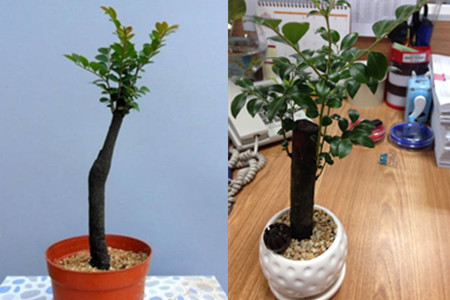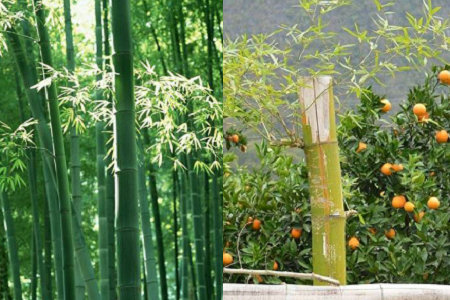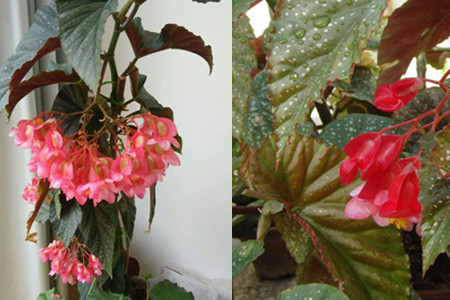Are lobular red sandalwood bonsai true? teach you how to tell the true and false of valuable potted plants.

Lobular red sandalwood is one of the outstanding red sandalwood, because of its hard wood, unique aroma loved by the majority of friends, in ancient times as royal furniture wood, ordinary people are very difficult to use. The growth of lobular red sandalwood is slow, and it takes 800 years to grow into wood and put into use, resulting in an extreme shortage of resources and soaring prices. After the founding of the people's Republic of China, the state forbids the felling of treasured wood, and lobular red sandalwood becomes popular as an ornamental bonsai, and interests make fake goods constantly on the market. How can we tell the authenticity of valuable bonsai?
At present, the plant used in the market to pretend to be a valuable bonsai is a kind of plant called black bone tea, because its leaves, root nodules and lobular red sandalwood are similar to those of red sandalwood, which are used by illegal businessmen to make profits by pretending to be genuine. In order to distinguish the true and false of lobular red sandalwood, we first need to know the characteristics of this tree and distinguish it from true or false by comparing it with black bone tea.
First, through the lobular red sandalwood leaves to distinguish between true and false.
Although lobular red sandalwood has the word "lobular" in its name, its leaves are actually not small. Red sandalwood belongs to the tree, the leaves are relatively large, generally oval or egg-shaped. The leaves of the red sandalwood tree grow in odd numbers, usually growing symmetrically on both sides of the leaf axis in a group of three.
Black bone tea belongs to shrubs, and its leaves are much smaller than lobular red sandalwood. Black bone tea leaves grow with each other, which seems to be a string of tea leaves.
Looking at the trunk of lobular red sandalwood, the bark of red sandalwood is generally dark brown, and the bark will crack as the year goes on, like a grid. The trunk of black bone tea is black, and there will be no color change when it melts.
Second, distinguish the true from the false by wood.
Lobular red sandalwood is famous for its hard texture and fine wood. it takes five years to grow to form a ring, so the weight of wood is so heavy that it will sink immediately if you put it into the water. Because of the high wood density, it is not easy to observe the growth rings of lobular red sandalwood, and the texture is crisscrossed and curled into strands.
Black bone tea is a shrub, wood hardness and density and lobular red sandalwood are far different, there will not be the phenomenon of sinking into the water.
Third, distinguish the true from the false by the taste.
Lobular red sandalwood has a faint wood fragrance, the fragrance is not obvious. If the saw cuts down a small piece of wood, carefully distinguish that the smell of sawn wood is similar to that of burning incense in a temple, which is also one of the reasons why lobular red sandalwood is so expensive.
Black bone tea plants have no taste, which is the more prominent difference between the two.
Fourth, distinguish the true from the false by the wood color.
As the name implies, the wood color of lobular red sandalwood is very special. Use a knife to cut the wood of lobular red sandalwood, the fresh cut color is orange or bright red, after a period of oxidation will become purple or dark purple.
There is also a relatively simple way to distinguish lobular red sandalwood, that is, a small piece of wood is scratched on white paper to see its scratch color. The scratches left by authentic lobular red sandalwood are purplish red. If the detritus of wood is soaked in alcohol, the exudate is purplish red, which is a good material for dyeing cloth, bright colors and not easy to fade.
At present, 99% of the lobular red sandalwood potted plants in the bonsai market are fake black bone tea. in fact, as long as you know a little about the characteristics of lobular red sandalwood, it is easy to tell the true and false bonsai by the difference between leaves and wood. Specially remind you to buy expensive bonsai must go to a fixed physical store, network sales of products can not directly contact the plant details, increasing the probability of being deceived.
How to raise a few key points of lobular red sandalwood bonsai to raise valuable potted plants
Red sandalwood is the first mahogany, lobular red sandalwood is the leader of red sandalwood, so it is of great value. Lobular red sandalwood is called a gift from heaven in Buddhist sutras, which has the function of detoxifying, repelling evil spirits and improving fengshui, so potted plants are not only used for ornamental purposes. As the saying goes, one inch of red sandalwood and one inch of gold, what are the skills of such a valuable plant culture? Let's talk about it in detail.
First, temperature requirements.
Lobular red sandalwood is a tropical plant from India, adapted to the temperature and climatic conditions of Southeast Asia, so like the sun, can not adapt to low temperature environment. The culture temperature of lobular red sandalwood is between 20 and 30 degrees Celsius, which is easy to freeze if it is lower than 3 degrees Celsius. Spring, summer and autumn can be raised in an outdoor environment, but they should be moderately shaded in summer and kept indoors in winter to avoid low temperatures.
In general, people like to put potted plants in the study or in the living room, where there is no direct sunlight, which is not suitable for the growth of plants that like the sun. Lobular red sandalwood in this environment for a long time will grow, the branches are getting longer and longer, the shape is not beautiful, because to put in a sunny position.
Second, how to water.
Lobular red sandalwood has a high demand for moisture, so it is a drought-intolerant tropical plant, so it needs to be watered once in two or three days. Lobular red sandalwood watering is skillful, watering should be thoroughly watered, but be careful that there can be no stagnant water in the basin. It can not be watered at noon when the sun is direct and the temperature is high. The evaporation of water vapor caused by high temperature will wither and kill the green plants. Lobular red sandalwood likes a more humid environment, you can use a spray can spray foggy water to create a humid environment.
Many friends breeding lobular red sandalwood bonsai can not grasp the timing and amount of watering, resulting in green plants lack of water, the following talk about how to deal with it.
1. How to deal with the initial stage of water shortage.
When you find that the bonsai branches are sagging, it shows that it is short of water. This state shows that green plants are relatively easy to deal with at the initial stage of water shortage, as long as they are watered once in the morning and once in the evening.
2. How to deal with the drying of young shoots caused by serious lack of water.
When the lack of water is serious, it will be found that the leaves of lobular red sandalwood are semi-withered, and the tender branches that have just grown become dry. At this time, you should trim off the dry branches, seal the wound with paint or wax, put the bonsai in a cool place, wait for it to sprout slowly, and pay attention to watering.
3. How to deal with the main trunk caused by water shortage.
When the water loss of bonsai is very serious, what if the trunk has dried up? The dry trunk should be cut off, after sealing the wound, the whole bonsai should be put in water to replenish water. Wait until the bonsai absorbs enough water and put it in a cool place to bring it back to life.
Third, how to apply fertilizer.
Lobular red sandalwood root system is more developed, and its own parasitic nodules have nitrogen fixation, so the requirement for the soil is not high, do not need frequent fertilization, you can dilute the green plant nutrient solution every other month and pour it into the soil with water.
Because of the particularity of its well-developed root system, leaflet red sandalwood pot culture can not directly replace flower soil with nutritious soil, nor should it bury nutrient fertilizer directly in the soil, which will damage the root system. Too much nutritious soil and fertilizer will also burn roots, which is disadvantageous.
Fourth, do not change the location of potted plants at will.
When your lobular red sandalwood grows well and has adapted to the existing environment, don't move the flowerpot at will, otherwise it will increase the growth burden.
These are the nursing skills of lobular red sandalwood, especially to remind you that red sandalwood is expensive and there are many imitation goods in the market. Please identify the authenticity before you buy it.
- Prev

What are the planting methods of chopped bamboo that can live without roots?
Bamboo gives people a sense of serenity, so many people like to use bamboo for environmental decoration. Although the vitality of bamboo is tenacious, it is also easy to take care of. But how should bamboo be planted? Can the bamboo that has been cut into segments survive without roots?
- Next

New plants are planted in three steps by cutting method of bamboo crabapple
Bamboo crabapple is a perennial herb of Begonia family and genus Begonia. It is an erect or scattered shrub with soft leaves in summer and autumn. Potted begonia is often used to decorate living rooms, shop windows or family windowsills, balconies, coffee tables, etc.
Related
- Fuxing push coffee new agricultural production and marketing class: lack of small-scale processing plants
- Jujube rice field leisure farm deep ploughing Yilan for five years to create a space for organic food and play
- Nongyu Farm-A trial of organic papaya for brave women with advanced technology
- Four points for attention in the prevention and control of diseases and insect pests of edible fungi
- How to add nutrient solution to Edible Fungi
- Is there any good way to control edible fungus mites?
- Open Inoculation Technology of Edible Fungi
- Is there any clever way to use fertilizer for edible fungus in winter?
- What agents are used to kill the pathogens of edible fungi in the mushroom shed?
- Rapid drying of Edible Fungi

